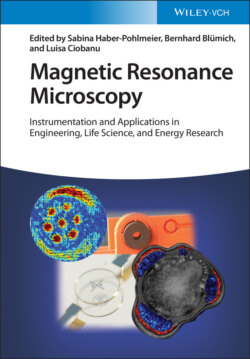Читать книгу Magnetic Resonance Microscopy - Группа авторов - Страница 68
3.5.2.2 Limited Frequency Bandwidth of Tuned Radiofrequency Coils
ОглавлениеIf the magnet is inhomogeneous, or has a built-in encoding field, the MR linewidth across the body will be larger than seen in canonical high-field scanners, which typically achieve proton linewidths of a few tens of Hertz over the brain. In addition to the encoding and reconstruction problems described earlier, the Q of the radiofrequency coil is often high enough so that the bandwidth (BW) of the coil is lower than that of the signal, diminishing detection in regions with high-frequency offsets.
On excitation, this could be compensated in the design of the radiofrequency pulse using knowledge of the coil’s response to counteract the effect at the frequencies at the edge of the coil’s response. Alternatively, one could simply damp the resonator with an external resistor switched in during transmit (at the expense of requiring increased radiofrequency power) [134]. But during reception, the high-Q coil will simply be inefficient at detecting spins in locations where the spin frequency exceeds the coil BW. The ability to receive across the full-imaging BW is critical, and becomes more difficult at low field. Low loss reception is important for maintaining the sensitivity of detection, so there is strong motivation to maximize Q by increasing L and reducing resistive losses in the coil. Furthermore, reduced radiofrequency losses in the tissue help keep the Q of head resonators in the 50–200 range across a wide variety of low- to mid-field strengths, since the coil BW (full width at half maximum of coil response) relates to Q through BW = v0/Q (where v0 is the Larmor frequency). As Q does not change much, in general the detection BW decreases at lower field. Assuming Q = 100 and an 80-mT magnet (v0 = 3.4 MHz), the expected BW of the coil is 34 kHz (compared with a 640-kHz BW for a Q = 100 coil at 1.5 T). Even for homogeneous magnets, a typical readout gradient of 10 mT/m will introduce a proton linewidth of 84 kHz over the 20-cm head. Thus, a receive coil constructed with desirable high-Q properties will introduce substantial shading across the FOV.
Increasing the receive coil Q with resistors is a poor strategy from the signal-to-noise ratio point of view since this introduces losses and thus radiofrequency noise. Lossless methods are needed to alter the frequency response of the tuned circuit. The Fano–Bode BW theory describes a general limit for the BW over which the impedance match of an MR coil can be achieved [135]. Cryoprobes at high field experience a similar issue [136]. In addition to traditional impedance matching methods, lossless manipulation of the tuned circuit frequency response can be addressed using a variant of preamplifier decoupling, typically used to reduce geometric coupling in arrays [137]. Traditional preamplifier decoupling uses a non-power-matched input impedance preamplifier to couple an extra parallel LC “trap” circuit to coil resonance. The lack of a power match is immaterial if the noise performance of the preamplifier is satisfactory with that matching condition. Because a power match is not used, it’s not clear if the Fano–Bode theory applies. Although known for causing a large perturbation to the coil’s frequency response, preamp decoupling at modest levels can create a minor split-resonance, which has the effect of lossless broadening the response. Figure 3.8 shows the frequency response of a low-impedance preamplifier (WanTcom Inc., Chanhassen, MN) connected to a coil tuned to 3.4 MHz. The strategy is able to reduce the coil’s power response variation over the desired imaging BW (shaded region of Figure 3.8) from 4.7 dB to 0.7 dB.
Figure 3.8 Response of a low-field magnetic resonance imaging coil with and without preamplifier decoupling. With mild preamplifier decoupling, the variation over the expected imaging bandwidth dropped from 4.7 dB to 0.7 dB.
